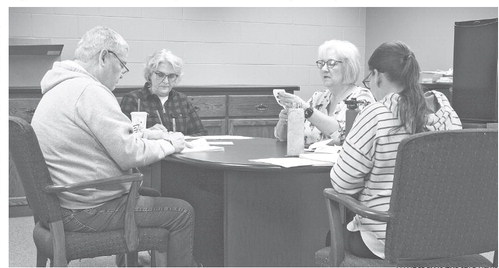County eyes shift in vacation/sick leave policies
Taylor County employees could soon be facing a major change in how vacation and sick days are handled.
At the Sept. 27 executive committee meeting, county administrative coordinator/ human resources director Nicole Hager outlined a planned conversion from the county’s current system of having employees with a set number of vacation and sick leave days to a paid time off (PTO) model that ideally provides flexibility to use the time off for vacation or sick leave.
The county is eyeing the change as a way to get a handle on the large payouts of accrued unused sick leave that have been paid to employees who have retired from the county in recent years and reduce the financial cost of the number of hours of unused sick leave paid out to employees each year.
Hager noted that in researching the PTO model the directive from board members was first to ensure that existing employees retain their earned benefi t time, second to mitigate the financial impact to Taylor County for payment of benefit time and finally to improve consistency in leave implementation for county employees.
Under current county policies, employees receive a set number of days of vacation based on their longevity with the county and a set number of sick days per year. County employees are able to bank unused sick leave up to 80 days (640 hours). Employees who are at the maximum of banked days currently get paid out for 75% of their unused hours up to a maximum of 72 hours per year. This is typically paid out on the first payroll of the new year. In January 2023, Taylor County paid out $39,023.27 for the annual sick leave payout.
If an employee resigns from county employment, they are paid out for unused vacation including pro-rated vacation accrued (based on 1/12 per month worked) that would have gone to the following year’s vacation. As of August 18, the county had paid out $14,454 in prorated vacation time to people who have left county employment. Sick leave is not paid out at resignation.
When an employee retires from the county, they are paid out for the unused vacation time, the pro-rated vacation they would have been accruing for the following year and for any banked sick leave up to 75% of 80 days, or up to 640 hours. In 2022, the county paid out $130,959 in banked sick leave to employees.
Hager noted the switch to a PTO model would eliminate the annual sick leave payout going forward and would remove the prorated payout formula.
In addressing the consistency across county employees, Hager noted there were currently different rules in place for those hired prior to 2013 and those after 2013, as well as differences between department heads and non-department heads.
The proposed PTO model provides one model for all county employees and does not differentiate between pre-2013 and post-2013 employees, or between department heads and non-department heads.
Under the proposed PTO plan, employees would accrue hours during the year that could be used for vacation, sickness or other personal time. Employees would still have to request the time off through the existing procedures.
Under the formula, employees would have five different accrual levels based on seniority.
Hager presented executive committee members with two options.
In both options, every employee begins at no accrued time, but it was noted the accrual was ongoing until maximums were reached. “We don’t have a start and an end, this is a continuous accrual,” said Rachel Ogle of the county’s human resources department.
In the first option, employees in their first five years of employment would earn .0962 PTO credit for each hour worked which would have the annual accrual of 200 hours (25 days). If they would leave county employment during that time, they could be paid out for 120 of those hours.
This accrual amount increased based on seniority with those at 20 plus years of employment earning an hourly accrual of .1538 per hour worked for an approximate accrual of 320 hours or 40 days over the course of the year with 192 hours eligible for payout on separation from the county.
Employees would be able to carry over 80 hours of unused time to the following year, but any unused PTO after the maximum accrual would be forfeited until PTO was used.
In the second option, there is no carryover and the separation payout would be up to the maximum amount accrued during that year.
Under this plan, the accrual rate is based on hours worked, so those on 32hour week schedules would accrue PTO slower than those on 40-hour week schedules. Part-time employees would also be eligible to accrue the PTO.
Under the proposals, new employees will be able to go negative in their PTO balance in their first year up to 40 hours, to account for that unlike the current system they will start with no sick days until they accrue time over the year. If the PTO bank is negative, employees must accrue enough time to make up for those days used. If an employee with a negative PTO bank leaves county employment they will be required to pay the county back for remaining balance.
Hager and committee members noted the goal is to not take anything away from current employees in the transition to a PTO model.
To that end, committee members asked if the county could say that for any existing employees what they have accrued under the current system would be locked into place and that going forward and January 1 the old process of banking days wouldn’t happen anymore?
“The short answer, it is a pretty flat no,” Ogle replied.
Instead, the committee members are looking that the employees would be paid out their time at the end of the year.
Committee member Scott Mildbrand expressed concern about being fair to constituents.
Committee member Mike Bub expressed concern about new employees. “I am concerned this would be very diffi cult for brand new employees,” Bub said, of having no time off available at the start. While it is not typical to take vacation within the first few months of employment, employees do not have the same control over illness of themselves or people they care for.
“What if we have a person chronically abusing sick time,” asked Sheriff Larry Woebbeking expressing concern about enforcement and if this would take away the department head’s ability to address those abusing sick time.
Because there is no differentiation between sick and other types of time off under the PTO model, the policies would need to be adjusted to reflect unplanned absences or unscheduled PTO days.
Committee members also discussed options on payout in retirement to define what that actually means. For example, if the employee is eligible for Wisconsin Retirement System benefits, or if it should be WRS plus a period of time.
“I think they should be here more than five years,” Bub said.
The suggestion was made to make it 10 years of county employment plus WRS age. “I don’t want to make it a big mountain to climb,” Bub said.
Highway commissioner Ben Stanfley raised concern coming at it from a different angle of, for example, someone who starts work for the county at age 20 and puts 20 or 25 years and decides to move to something else but is not at retirement age to receive WRS although they will have been fulled vested in it.
The suggestion was made to go with WRS age plus 10 years of service or 20 years of service.
Mildbrand also asked to see the financial impact to the county of paying out the earned sick days for all the current employees as they switch to the new PTO model. There was also discussion of how that payout could take place, whether it should be a cash payout or placed into a Health Reimbursement Account for the employees to use for future healthcare costs.
“Cash payout is easiest to manage,” Hager said, however she said it is up to the county on what they want to do.
Executive committee members voted to give their approval to going with Option 1 and sending it to the finance and personnel committee before it goes to the full county board for final approval.




